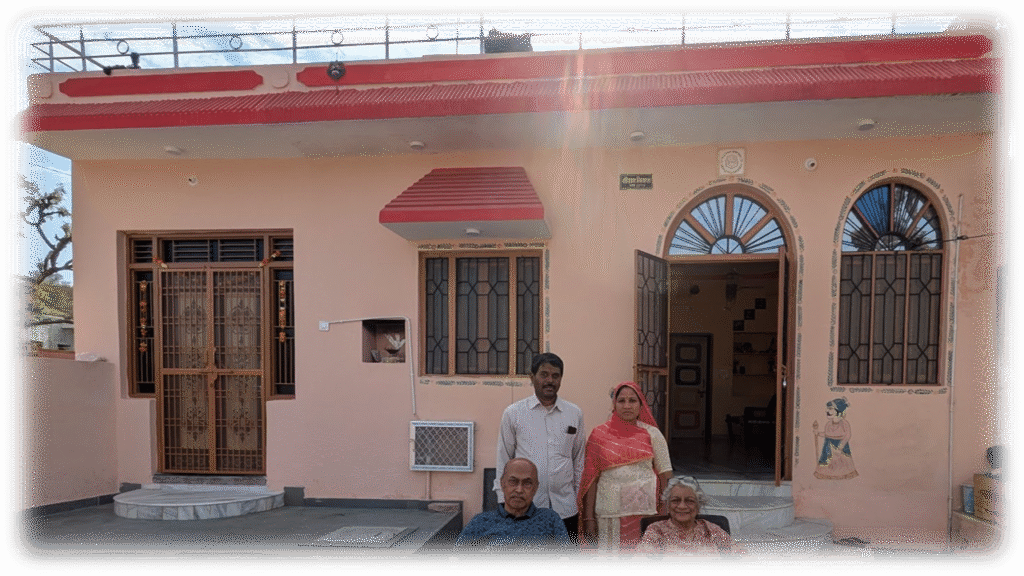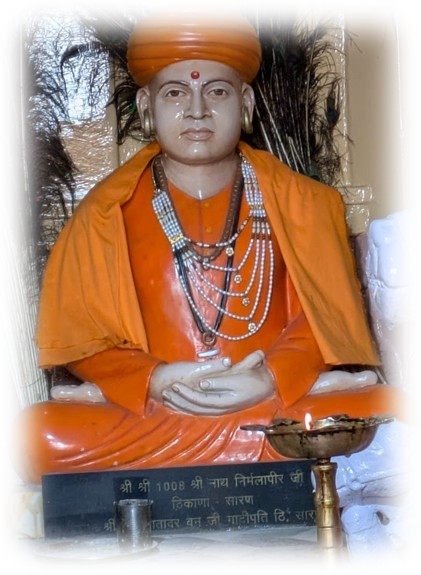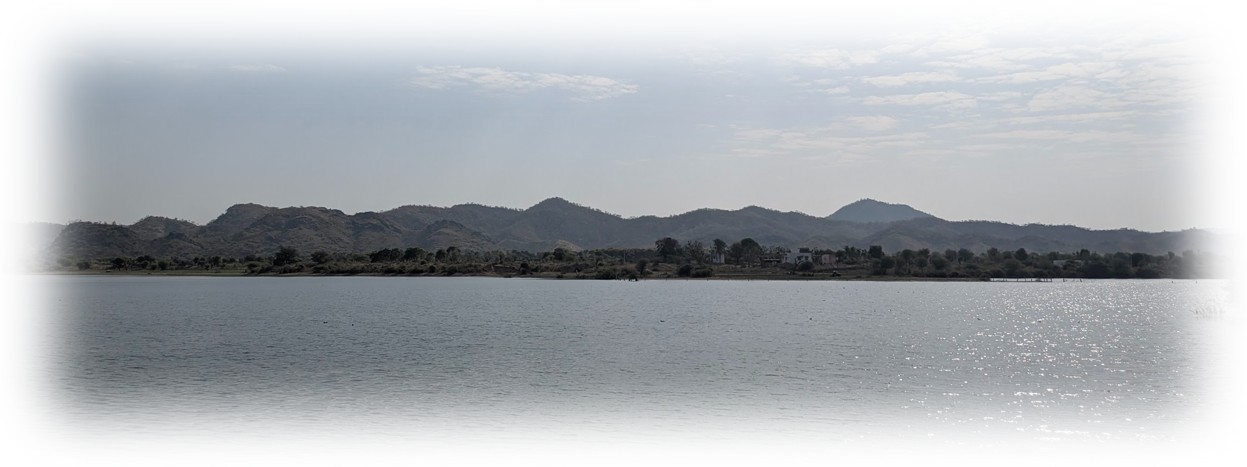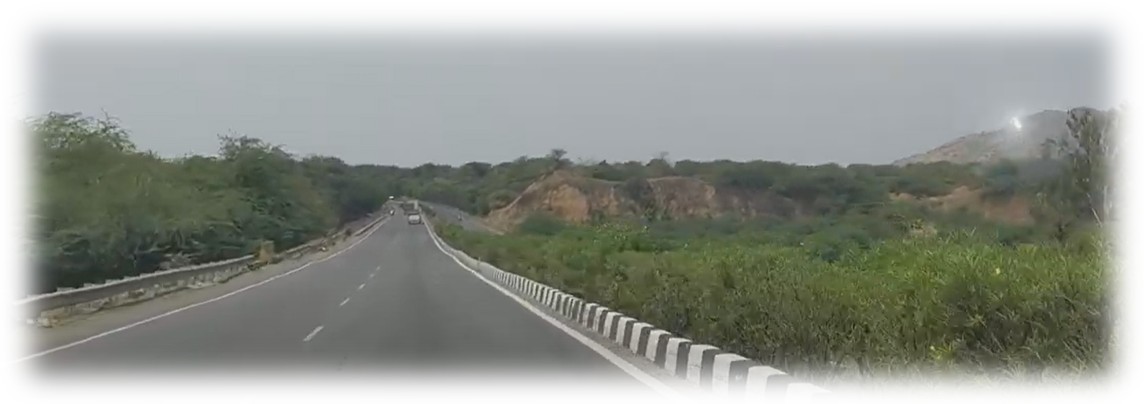
We hadn’t noticed it while on the move, but the 475-kilometre journey had quietly drained the life from our limbs. As we settled into the languid rhythm of the village our aching muscles signalled a craving for relief. We spread ourselves on our backs on the inviting charpaees in Prabhu’s courtyard. Steaming cups of chai and crisp, golden palak pakoras made a vain attempt to rejuvenate us, as the day folded into dusk.
By 7:30 PM, the village had fallen into a hush so complete that one would have literally heard a pin drop. Overhead, the sky spread into star-studded spectacle of the infinite. As a mild chill kissed the gentle breeze, I lay on the charpaee, eyes half-closed, letting the quiet wrap around me in a soft cocoon. For a moment, I wasn’t anywhere, and I was everywhere! I was floating in a bubble of silence, and time stopped still.
Then, from somewhere at the edge of that stillness, came a voice, first soft and then clear like a tolling bell— “Dinner’s ready.” And what a dinner it was. Bajra rotis, hot and smoky from the chulha, sabzi made from palak that had been plucked just hours ago, dal fragrant with desi ghee, and tangy and textured lasoda pickle next to a small mound of rice. Each mouthful was a hymn to the land the food came from.
Bellies full, hearts fuller, we sat around reminiscing about road trips with Prabhu and our loveable Labrador, Tito. Those journeys often wound through small towns and unfamiliar terrain, with mid-journey night halts in government guest houses—thanks to friends in the right places. These guest houses were our sanctuaries, welcoming not just us but Tito too. We fondly recalled the guest house in Dhule, where we’d stayed many a time on our way from Ahmedabad to Nagpur and back. It had a large courtyard Tito could claim as his kingdom, where he vigorously rubbed his back on the grass, and raced around in circles, with his upright tail wagging like a metronome set to joy. By 9 PM everyone was ready to hit the sack.
Legend of Baba Nirmalaji of Saran
After a leisurely breakfast of piping hot aloo parathas on the terrace, with the morning sun casting a golden glow over the fields, we got ready to hit the road. Our destination: the first of several storied sights near Sadakmaliya, each echoing with legends and cultural richness.
By 11 AM, we rolled into Saran village, 15 kilometers from Sadakmaliya. This unassuming village holds a regal past — once ruled by King Pula Saran of the Saran Jat community in the 15th century. His reign extended over Saran and nearly 360 surrounding villages, forming part of the historic Jangladesh region of Rajasthan. At the heart of the village stands the Saran Palace, remarkably well-preserved and a stunning example of traditional Rajasthani architecture — complete with intricate stonework, delicate carvings, open courtyards, elegant havelis, and fortified walls that whisper stories of a bygone era.
Right next to the palace is the Baba Nirmalaji Temple, a spiritual landmark with deep local reverence. Baba Nirmalaji, born in Saran, showed profound spiritual leanings early in life and grew up to become a revered saint. His influence still radiates through the region — his teachings celebrated, his memory honored, and his temple alive with faith. The statue of Baba Nirmalaji, placed with reverence in the sanctum sanctorum, continues to be the spiritual nucleus for numerous villagers and devotees.

As we explored the temple, Prabhu, our guide, shared a remarkable tradition — one that blurs the lines between spirituality and justice. In Saran, the temple is more than a sacred site; it is the seat of truth and justice. When someone is accused of wrongdoing, he is summoned by the village elders to appear at the temple within seven days. At the appointed hour, both the accuser and the accused gather before the villagers and elders. Then comes the defining moment: the accused is asked to step over the threshold and enter the garbhagrih, the sanctum housing Baba Nirmalaji’s statue.
Here’s where belief takes center stage — it is said that if the person is indeed guilty, he will be physically unable to cross the threshold. What is ordinarily a simple step would become an impossible one for the guilty. In fact, many confess before the day arrives, unwilling to face the weight of the moment and the potential public shame of failing the test. This profound form of justice, rooted in faith, has withstood the test of time — passed down through centuries of tradition.
Intrigued, we turned to the priest and asked if the practice continues in modern times. With a grave smile he nodded, affirming that even today, villagers occasionally resolved disputes through this age-old method, relying not just on logic, but on belief, integrity, and the enduring spiritual presence of Baba Nirmalaji.
A Sacred Ascent: To Marwar’s Vaishno Devi
After a quick lunch and a short rest at home, we were back on the road—refreshed and ready for the next leg of our exploration. Our destination: Kotada Mata Mandir, a place often called Marwar’s very own Vaishno Devi. Just 4 kilometers from Sadakmaliya, the temple holds a magnetic pull for thousands of devotees, especially during Dussehra, when the hills echo with faith, chants, and celebration.
Why the comparison with Vaishno Devi? Because Kotada Mata, like her northern counterpart, is believed to embody the divine feminine force (Shakti)—a blend of the mighty goddesses Kali, Saraswati, and Lakshmi. It’s not just a temple; it’s a symbol of strength, wisdom, and abundance—all rolled into one.
The drive itself was a treat. We meandered through stretches of lush farmlands, patches of forests, and gradually began climbing the gentle folds of the Aravalli hills. As we gained altitude, the landscape began to open up around us—quiet, raw, and beautiful.
Our vehicle brought us to a plateau from where the climb truly began—a flight of over 100 stone steps led upward to the temple courtyard, built dramatically against the hillside, halfway up the slope. A short climb, but just enough to shift your mind from the mundane to the sacred.
What awaited was more than just a temple. Through another small set of steps from the courtyard, we entered a natural cave, the sanctum sanctorum of the temple. The entrance is carved directly into the rock, with a low ceiling that requires every visitor to bend in reverence—an involuntary bow before the goddess. There’s something incredibly humbling about that moment: stepping into the cool, dim cave, heart quietly thudding, senses alert.
The legend of the place is no less powerful. It’s said that Kotada Mata once protected the King of Kantaliya from a surprise attack by the King of Jodhpur—her divine shield preserving justice and honor. Stories like these don’t just live in books—they echo in the whispers of the wind and the quiet devotion of every visitor who makes this climb.
And then there’s the view. From the courtyard, the vast panorama of the Aravallis stretches out in all directions—a rolling sea of hills, trees, and distant villages. It’s the kind of view that silences you into reverence for nature.
One final detail caught our eye before we left: a board listing names of donors, a simple tribute to the faith of those who give back. And among them stood a familiar name—Prabhu Singh Chauhan—yes, it was Prabhu who was with us, who had donated his entire first salary from IIMA in 2010. A small line on a board, but a story of deep devotion and gratitude behind it.
Kotada Mata isn’t just a destination—it’s a quiet journey inward, a climb that humbles the mind and uplifts the spirit.
Soaking in Nature – A Day Through Lakes, Forests, and Waterfalls
Day two began on a delicious note—with a hot plate of poha made by Bipin, setting the tone for what would turn out to be a soul-refreshing road trip. We had a long drive ahead of us, winding through lakes, hills, and thick forests, with plans to grab lunch along the way and make it back home by midafternoon. Or so we thought.
Our first stop was the serene Todka Naka Lake, just 8 kilometers from where we were staying. Surrounded by the Aravalli hills, this tranquil lake is part of a beautifully interlinked system of water bodies that includes Bandi River Lake and Sonai Maji Lake. What’s fascinating is how Rajasthan, often thought of as dry and arid, has nurtured a smart and sustainable relationship with water—blending natural lakes with man-made ones to preserve every drop. The peaceful vibe, mirrored water, and chirping birds made it the perfect spot for photography and quiet reflection. We made a mental note: next time, this would be our picnic haven.

From there, we hit the road toward Kali Ghati, about 30 kilometers away. The name literally means “Black Valley”—and it lives up to it. As we approached, the valley appeared dark and shadowy, thanks to the jet-black bark of the trees dotting the forest. This stretch of the Aravallis is home to Khejri, Babul, and Kumat trees—tough, resilient, and crucial to the survival of local wildlife—jackals, blackbucks, chinkaras, peacocks, partridges, and kites. The silence of the forest was occasionally broken by bird calls—a reminder of how alive this place still is, despite the creeping signs of human intrusion.

After a scenic 15-kilometer drive through the forest, we reached Kamli Ghat, perched near the Todgarh-Raoli Wildlife Sanctuary. With its rolling green hills and dense cover, Kamli Ghat felt like stepping into a forgotten pocket of wilderness. Kamli Ghat is home to Bheelberi Waterfall—which at a 55-meter-high cascade is the highest waterfall in Rajasthan. We could imagine how stunning it must look during the monsoon, surrounded by mist and echoing with the sound of rushing water.
Hunger caught up with us, and luckily, Kamli Ghat also doubles up as a bustling bus junction—with plenty of roadside eateries offering authentic Rajasthani fare. One quick search and we landed ourselves in a small place serving Jodhpur-style snacks and sweets. From Mirchi Vadas to Pyaaz Kachoris, Moong Dal Halwa to Ghevar, Rabri to Mava Kachori, we went all in—and being a group of six meant we could sample (almost) everything on the menu. Every bite was a burst of flavor, and we left the place in a happy food coma.
The drive back was quiet—partly because we were too full to talk, partly because the landscapes had lulled us into a peaceful daze. A lazy nap followed back home, only to be interrupted by the bittersweet realization when we woke up that our trip was almost over. We’d be heading back to Ahmedabad the next morning.
But one thing was clear—we were not done with Sadakmaliya just yet. There’s more to explore, more to soak in. And we’ll be back.
#Sadakmaliya #KaliGhati #KotadaMata #Saran #BabaNirmalaji #Kantaliya #Marwar #KamliGhat #Footloose #TravelTale #Pali
